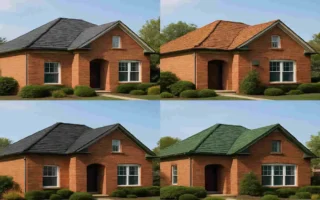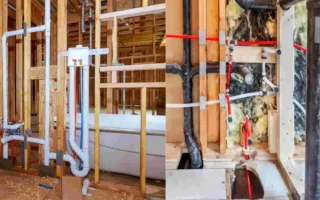When you look at a house, the roof is one of the first things you notice. It’s not just a stylish addition to your home; it’s a crucial part of keeping you and your family safe and comfortable. But have you ever looked at the edges of your roof? Those are called eaves, and they play a vital role in protecting your home.
What Are Eaves on a House?

Defining Eaves
Eaves are the edges of a roof that overhang the walls of a house. They are the parts of the roof that extend beyond the exterior walls, creating a protective barrier between your home and the elements.
Location and Anatomy
Eaves are located at the bottom edge of a roof, where the roof meets the walls. They consist of several components, including:
- Fascia: The vertical board that runs along the edge of the roof
- Soffit: The underside of the eaves, which can be open or closed
- Rafters: The sloping beams that support the roof
Types of Eaves
There are several types of eaves, each with its own unique characteristics:
- Overhanging eaves: These eaves extend far beyond the walls, providing ample protection from the elements.
- Boxed eaves: These eaves feature a closed soffit, creating a neat, finished appearance.
- Open eaves: These eaves have an exposed soffit, allowing for better ventilation.
- Soffit eaves: These eaves feature a soffit flush with the walls, creating a streamlined look.
The Function and Benefits of Eaves
Protection from the Elements
One of the primary functions of eaves is to protect your home from the elements. They act as a barrier, shielding your walls and foundation from rain, snow, and sun.
Preventing Water Damage
Eaves play a crucial role in preventing water damage to your home. By directing water away from your walls and foundation, you help keep your home dry and prevent costly repairs.
Shading and Energy Efficiency
Eaves can also help shade your windows, reducing the amount of heat that enters your home. This can lead to lower energy costs, especially during the hot summer months.
Ventilation and Airflow
Eaves also help ventilate your attic. By allowing air to flow through the soffit vents, eaves help reduce moisture and heat buildup, keeping your home more comfortable and energy-efficient.
Enhancing Curb Appeal
In addition to their practical benefits, eaves can enhance your home’s curb appeal. With various design options and materials, you can choose eaves that complement your home’s architectural style and add to its overall aesthetic.
Roof Health and Longevity
Finally, eaves are a critical factor in the overall health and longevity of your roof. By protecting your roof from the elements and promoting proper ventilation, eaves help extend its lifespan and save you money in the long run.
Materials and Design Options for Eaves

Common Materials
When it comes to eaves, there are several common materials to choose from:
- Wood: A traditional choice that offers a warm and natural look
- Vinyl: A low-maintenance option that is resistant to rot and insects
- Aluminum: A durable and lightweight material that is easy to Install
- Fiber cement: A strong and fire-resistant material that can mimic the look of wood
Pros and Cons of Each Material
Each material has its own pros and cons when it comes to durability, maintenance, and aesthetics:
Material Durability Maintenance Aesthetics
Wood Moderate High Warm and natural
Vinyl High Low Modern and sleek
Aluminum High Low Sleek and durable
Fiber cement is High, Moderate, Versatile, and fire-resistant
Design Trends and Customization
When it comes to eaves, there are many house design trends and customization options to consider. Some popular choices include:
- Trim styles: From streamlined and straightforward to ornate and decorative, there are many trim styles to choose from.
- Paint colors: Eaves can be painted to match your home’s exterior or to create a contrasting accent.
- Soffit venting: Depending on your climate and ventilation needs, you can choose from a variety of options.
Material Choice and Functionality
The material you choose for your eaves can impact their functionality and lifespan. For example, wood eaves may require more maintenance than vinyl or aluminum eaves, but they can offer a more traditional and warm look. Consider your climate, budget, and aesthetic preferences when choosing the right material for your eaves.
Common Issues with Eaves and How to Address Them
Signs of Damage
Over time, eaves can develop various issues that can compromise their functionality and appearance. Some common signs of damage include:
- Rot: Caused by moisture exposure and poor ventilation
- Peeling paint: A result of weather exposure and lack of maintenance
- Insect infestation: Attracted to wood eaves and causing structural damage
- Sagging eaves: A sign of weakened or damaged rafters
Causes of Eave Problems
Eave problems can be caused by a variety of factors, including:
- Poor installation: Improper installation can lead to leaks and other issues
- Weather exposure: Constant exposure to the elements can cause wear and tear
- Lack of maintenance: Neglecting to clean and inspect your eaves can lead to problems
DIY Repair Tips vs. Professional Help
When it comes to repairing your eaves, you may be tempted to tackle the job yourself. However, some repairs are best left to the professionals. Here are some DIY repair tips and when to call a pro:
- DIY repairs: Small repairs, such as touch-up painting or replacing a damaged soffit panel, can often be done by homeowners.
- Professional help: More extensive repairs, such as replacing rotted rafters or sagging eaves, should be left to experienced roofing professionals.
Maintenance Checklist
To keep your eaves in top condition, follow this maintenance checklist:
- Clean your eaves: Remove debris and dirt regularly to prevent clogs and damage.
- Inspect your eaves: Look for signs of damage, such as rot, peeling paint, or insect infestation, and address them promptly.
- Check your ventilation: Ensure that your soffit vents are clear and functioning properly to promote good airflow.
- Paint and seal: Keep your eaves painted and sealed to protect them from the elements and extend their lifespan.
Installing and Inspecting Eaves: What Homeowners Should Know

Installation Process
Installing new or replacement eaves is a job best left to experienced professionals. However, it’s helpful to understand the basic process:
- Remove old eaves: If you’re replacing existing eaves, the first step is to remove the old ones.
- Prepare the area: Clean and prepare the area where the new eaves will be installed.
- Install the fascia: The fascia is typically installed first, followed by the soffit and rafters.
- Finish and seal: Once the eaves are installed, they are finished and sealed to protect them from the elements.
Building Codes and Regulations
When installing eaves, it’s essential to consider local building codes and regulations. These may dictate the size and ventilation requirements for your eaves, so be sure to check with your local authorities before starting any work.
Inspecting Eaves for Damage
Regular inspections are key to keeping your eaves in good condition. Here’s how to inspect your eaves for early warning signs of damage:
- Look for rot: Check for soft or discolored wood, which can indicate rot.
- Check for peeling paint: Peeling paint can be a sign of weather exposure and lack of maintenance.
- Inspect for insects: Look for signs of insect infestation, such as small holes or sawdust.
- Check for sagging: Sagging eaves can indicate weakened or damaged rafters.
Professional Inspection Techniques
When a professional inspects your eaves, they may use various tools and techniques, such as:
- Ladders and scaffolding: To access the eaves safely and efficiently
- Moisture meters: To detect hidden moisture and rot
- Infrared cameras: To identify heat loss and ventilation issues
- Drone inspections: To get a bird’s-eye view of your roof and eaves
DIY Inspection and Maintenance
While professional inspections are essential, you can also perform regular DIY inspections and maintenance to keep your eaves in top condition. Here are some tips:
- Use a ladder: Safely climb a ladder to get a close look at your eaves.
- Look for signs of damage: Keep an eye out for rot, peeling paint, insects, and sagging.
- Clean your eaves: Remove debris and dirt to prevent clogs and damage.
- Check your ventilation: Ensure that your soffit vents are clear and functioning correctly.
Frequently Asked Questions About Eaves on a House
What is the difference between eaves and soffits?
Eaves are the edges of a roof that overhang the walls, while soffits are the underside of the eaves. Soffits can be open or closed, depending on the type of eaves.
How far should eaves extend from the side of the house?
The ideal eave extension can vary depending on your climate and local building codes. In general, eaves should extend at least 12 inches from the side of the house to provide adequate protection from the elements.
Can eaves help reduce summer cooling costs?
Yes, eaves can help shade your windows and reduce the amount of heat that enters your home, lowering summer cooling costs.
How do eaves impact roof warranty or insurance?
The condition of your eaves can affect your roof warranty or insurance coverage. If your eaves are damaged or poorly maintained, it could void your warranty or affect your insurance coverage. Be sure to keep your eaves in good condition to protect your investment.
Are eaves necessary in all climates?
While eaves are beneficial in all climates, they may be more crucial in certain areas. In regions with heavy rainfall or snowfall, eaves are essential for protecting your home from water damage. In warmer climates, eaves can help shade your windows and reduce cooling costs.




